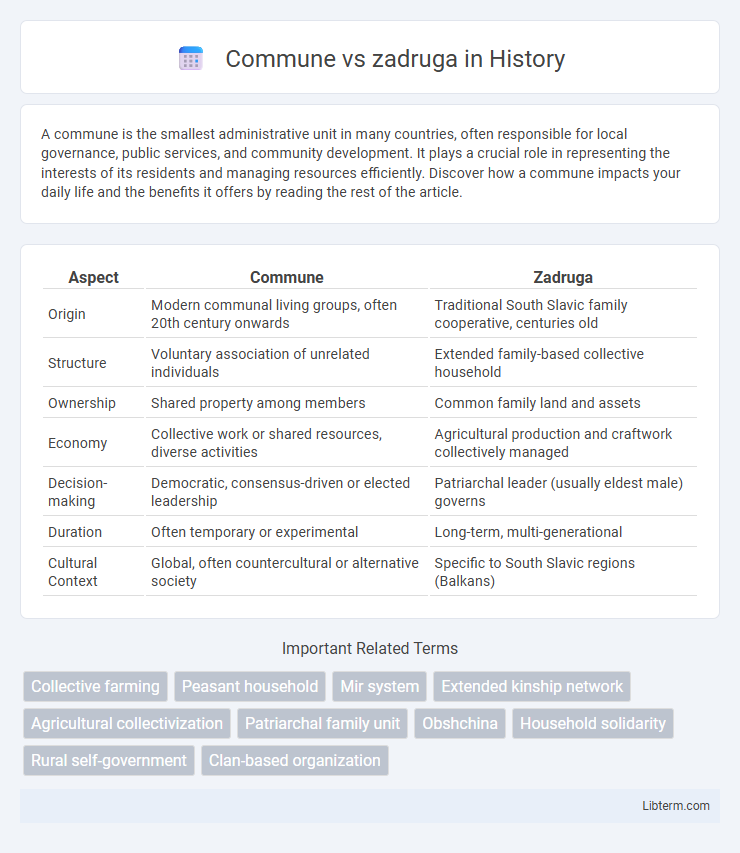A commune is the smallest administrative unit in many countries, often responsible for local governance, public services, and community development. It plays a crucial role in representing the interests of its residents and managing resources efficiently. Discover how a commune impacts your daily life and the benefits it offers by reading the rest of the article.
Table of Comparison
| Aspect | Commune | Zadruga |
|---|---|---|
| Origin | Modern communal living groups, often 20th century onwards | Traditional South Slavic family cooperative, centuries old |
| Structure | Voluntary association of unrelated individuals | Extended family-based collective household |
| Ownership | Shared property among members | Common family land and assets |
| Economy | Collective work or shared resources, diverse activities | Agricultural production and craftwork collectively managed |
| Decision-making | Democratic, consensus-driven or elected leadership | Patriarchal leader (usually eldest male) governs |
| Duration | Often temporary or experimental | Long-term, multi-generational |
| Cultural Context | Global, often countercultural or alternative society | Specific to South Slavic regions (Balkans) |
Introduction: Understanding Communes and Zadrugas
Communes represent collective living arrangements where resources and responsibilities are shared equally among members, fostering a cooperative social environment. Zadrugas, traditional South Slavic family units, emphasize extended kinship ties and communal land ownership, often led by a patriarch who manages collective affairs. Both models highlight cooperative living but differ in cultural origins, governance structures, and the balance between individual autonomy and group cohesion.
Historical Origins of the Commune
The historical origins of the commune date back to medieval Europe, particularly in France where peasants formed tightly-knit communities to manage land collectively and ensure survival during feudal times. Communes often emerged as a response to oppressive feudal systems, aiming for shared ownership and cooperative decision-making. In contrast, the zadruga originated in the Balkans, especially among South Slavic peoples, as extended family units organizing communal living and agricultural work based on kinship ties.
The Zadruga: Roots in Balkan Traditions
The zadruga is a traditional Balkan communal living arrangement characterized by extended families residing and working together on shared agricultural land, fostering strong kinship ties and collective responsibility. Rooted in South Slavic customs, the zadruga emphasizes communal ownership and cooperation, contrasting with modern commune structures that often arise from ideological or social movements. Its deep historical presence in Balkan societies highlights cultural values centered on family unity, land stewardship, and mutual support within rural communities.
Key Structural Differences Between Communes and Zadrugas
Communes are collective living arrangements where members share property and resources equally, often emphasizing voluntary association and individual autonomy within the group. Zadrugas are traditional South Slavic family-based cooperatives characterized by a patriarchal structure, joint ownership of land, and intergenerational housing under one roof. Key structural differences include communes' focus on ideological equality and collective decision-making, contrasting with zadrugas' hierarchical family roles and strong kinship ties governing daily operations.
Social Organization and Hierarchy Comparisons
Communes typically feature an egalitarian social organization where resources, labor, and decision-making are shared equally among members, minimizing hierarchical distinctions. In contrast, zadruge often incorporate a patriarchal hierarchy centered around an elder male figure who holds authority over family members and communal assets, structuring social roles within the group. This fundamental difference reflects how social cohesion and governance are maintained, with communes emphasizing collective participation and zadruge relying on established leadership and family lineage.
Economic Practices in Communes vs Zadrugas
Communes emphasize collective ownership of resources, shared labor, and decision-making through consensus to ensure equal distribution of goods and services among members. Zadrugas operate on a patriarchal extended family model, where economic activities revolve around agriculture and livestock, with profits pooled and managed by the family head. The economic structure of communes centers on communal pooling of labor and resources for common welfare, while zadrugas integrate family ties with cooperative labor and profit-sharing.
Role of Family and Kinship in Each System
In a commune, the role of family and kinship is often de-emphasized as emphasis lies on collective ownership and shared responsibilities among unrelated individuals. In contrast, a zadruga centers its social and economic structure around extended family units, with kinship ties defining roles, labor division, and property management. This familial foundation in a zadruga ensures mutual support and cohesive decision-making based on blood relations.
Communal Decision-Making Processes
Communes utilize direct democratic decision-making, where all members participate in discussions and vote on community issues, fostering transparency and collective responsibility. Zadrugas, rooted in South Slavic traditions, operate through a patriarchal or elder council that makes decisions on behalf of the extended family group, balancing individual interests with group welfare. Both systems emphasize communal harmony but differ in their approach to inclusivity and authority distribution during decision-making processes.
Influence and Legacy in Modern Societies
Communes and zadrugas have significantly influenced modern cooperative living and community-based resource management by promoting collective ownership and shared responsibilities. The legacy of zadrugas, traditional South Slavic family cooperatives, is evident in contemporary Balkan social structures emphasizing familial ties and communal labor. Communes contribute to modern sustainability movements by fostering eco-friendly practices and social equality through collective decision-making and resource sharing.
Conclusion: Lessons from Communes and Zadrugas
Communes and zadrugas demonstrate the advantages of collective ownership and shared resources in fostering social cohesion and economic resilience. Both systems highlight the importance of cooperative labor and mutual support, which can enhance community stability and sustainability. Lessons from these models emphasize that successful communal living depends on structured governance, cultural alignment, and adaptability to changing social contexts.
Commune Infographic

 libterm.com
libterm.com